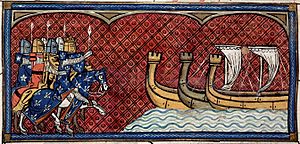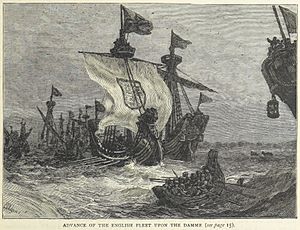Battle of Damme facts for kids
51°15′N 03°16′E / 51.250°N 3.267°E
Quick facts for kids Battle of Damme |
|||||||
|---|---|---|---|---|---|---|---|
| Part of the Anglo-French War (1213–14) | |||||||
 Philip II awaits his fleet |
|||||||
|
|||||||
| Belligerents | |||||||
| Kingdom of France | Kingdom of England County of Flanders |
||||||
| Commanders and leaders | |||||||
| Savari de Mauléon | William Longespée, 3rd Earl of Salisbury | ||||||
| Strength | |||||||
| Unknown, but large | Unknown | ||||||
| Casualties and losses | |||||||
| 300 ships captured, over 100 burned; remaining ships scuttled. | Unknown | ||||||
The Battle of Damme was a major naval battle fought on May 30 and 31, 1213. It took place during the Anglo-French War of 1213–1214. An English fleet, led by William Longespée, unexpectedly found a very large French fleet. This happened near the port of Damme in Flanders, which is now part of Belgium.
Most of the French sailors were not on their ships. They were ashore, exploring and gathering supplies. The English quickly attacked. They captured 300 French ships that were anchored. They also looted and burned another hundred ships that were pulled onto the beach. The main French army, led by King Philip II of France, was nearby. They were trying to capture Ghent. When King Philip heard the news, he quickly marched his army to Damme. He arrived in time to help the French soldiers defending the town. He also drove away the English landing parties. To stop the English from taking more ships, Philip ordered the rest of his fleet to be burned. This English victory brought a lot of valuable goods back to England. It also stopped France from invading England right away. Many people see this as the first big naval victory in English history.
Contents
Why Did the Battle Happen?
When King John became King of England in 1199, he wanted to make his kingdom bigger. He tried to take back lands in Normandy from King Philip II of France. But King John lost most of his lands in France by 1204. After this, John kept trying to make friends with other rulers against Philip. He hoped to get his lands back.
In 1208, John's nephew, Otto, became the Holy Roman Emperor. Otto had promised to help John. By 1212, both John and Otto were having problems with Pope Innocent III. King John had refused to accept the Pope's choice for the Archbishop of Canterbury. Because of this, the Pope stopped most church services in England in 1208. He also removed John from the Church in 1209. King Philip of France decided to use this situation to his advantage. He helped a rebellion in Germany. King John then supported Otto. Philip saw this as a chance to invade England.
To get all his nobles to help him invade England, Philip said that John was an enemy of the Church. This made his attack seem like a religious duty. He called a meeting of French nobles. Most of them came, except for Ferdinand, Count of Flanders. Philip was encouraged by the Pope's representative, Pandulf Verraccio.
However, Verraccio was also secretly talking with King John. John agreed to accept the Pope's decisions in church matters. In return, the Pope offered John the kingdom of England and lordship of Ireland. John would rule these lands as the Pope's loyal follower. Once this agreement was made in May 1213, Verraccio told Philip he could not invade England. Attacking a loyal follower of the Pope would be a serious wrong. Verraccio suggested that Philip should instead punish Ferdinand of Flanders. Ferdinand had refused to help Philip against England. Philip agreed and marched his army into Flanders. This started the Anglo-French War of 1213–1214.
Ships of the Time
In those days, special warships called galleys were used. These ships were long and narrow. They were powered by oars and sails. Galleys were good for fighting in shallow harbors. They could also move quickly, which made them useful for surprise attacks.
Both the English and French also used merchant ships called cogs for their navies. Cogs were rounder and had a deep bottom. They were moved by one large sail. Cogs were mainly used to carry goods. But they could be turned into warships. Workers would add wooden towers, called "castles," to the front and back. They also put fighting platforms at the top of the mast. From these high spots, soldiers could shoot arrows or drop stones onto enemy ships.
A writer from that time, William the Breton, said the French fleet had about 1,700 ships. But modern historians think this number is much too high. They believe the actual number was less than 500 ships. We have better information for the English fleet. In 1206, England had 50 galleys. By 1211, they had over 50 ships, including 20 galleys. Building and keeping these fleets was very expensive. In 1212, it cost over £3,500 a year, which was a huge amount of money back then. For the 1213 battle, King John tried to get every English merchant ship that could carry six or more horses.
The Battle at Damme
The French fleet was first gathered to carry soldiers to invade England. But instead, it was used to support the army on land. The fleet met at Boulogne. Savari de Mauléon, a French noble who had worked for King John, was put in charge. The ships were full of supplies like wine and food. They also carried the army's pay and the personal items of the French nobles. The fleet then sailed to Gravelines and then to the port of Damme. Damme was a very important trading port in Europe at that time. It was located on the Zwyn river mouth.
Meanwhile, the French army marched by land and began to attack Ghent. In England, King John had gathered his own fleet. He sent it to Flanders on May 28, 1213. This fleet was led by William Longespée. Its job was to help John's friend, Ferdinand, Count of Flanders.
The English ships carried 700 English and Flemish soldiers. They also had many hired fighters. On May 30, they entered the Zwyn river mouth. There, they were surprised to find the huge French fleet. Most of the French ships were pulled up onto the beach. Many of the French sailors were not on board. They were busy exploring and taking things from the nearby area. The English first thought the ships belonged to their Flemish friends. But after checking, they realized they were French and mostly empty. They attacked! They quickly captured 300 ships that were anchored. They killed the few sailors who were on board. Another 100 ships were robbed and then burned on the beach after their crews ran away. The next day, the English attacked the remaining ships. They also tried to attack the town of Damme, but they were pushed back. Both English and French writers from that time agree that the French lost about 400 ships.
The Flemish soldiers who came with the English then landed. They looked at Damme. Since it was well-guarded, they went around it and moved towards Bruges. When King Philip heard about the disaster, he stopped attacking Ghent. He marched his army quickly to Damme. Part of his army met the Flemish army near Bruges and defeated them. Philip's army reached Damme on June 2. They arrived just in time to help the French soldiers defending the town.
At Damme, Philip saw English ships still taking or burning his remaining ships. He was very angry. He didn't trust his sailors, most of whom were from areas that used to belong to England. He also didn't trust their commander. So, he ordered the rest of his ships to be burned. This was to stop them from falling into English hands. He also ordered the town of Damme to be burned. Philip wanted to make the Flemish pay for his retreat. He ordered that all towns he passed through should be destroyed. He also ordered that farmers should be killed or taken prisoner and sold. He forced the Flemish cities he had captured to pay him a huge sum of money, 30,000 marks, to release the people he had taken hostage.
What Happened Next?
The English fleet went back to England with the captured ships and many valuable goods. One writer at the time said, "never had so much treasure come into England since the days of King Arthur." The success at Damme ended any French plans to invade England that year. It also greatly reduced their resources. However, it did not stop the French army on land.
Even so, King John began to plan his own invasion of France. He wanted to win back his lost lands. At first, the English nobles were not very excited about this trip. This delayed his departure. So, it wasn't until February 1214 that he landed in France. John planned to attack from the south. His friend Otto, the Holy Roman Emperor, would attack from Flanders with Ferdinand. John did take back some land, but he was forced back after losing a battle to Philip's son, Louis, on July 2. Soon after, King Philip completely defeated Otto and Ferdinand's army at the Battle of Bouvines. This ended King John's hopes of getting his lands back in Europe.
Savari de Mauléon, the French commander at Damme, later returned to serve England. In 1216, King John appointed him to a special group. This group helped rule England for the new nine-year-old king, Henry III.
Images for kids




